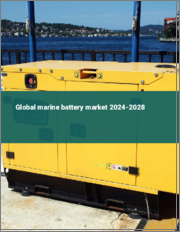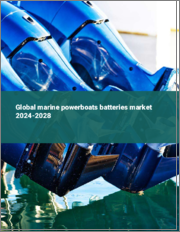
|
시장보고서
상품코드
1658056
선박용 배터리 시장 규모, 점유율, 성장 분석 : 배터리 선박별, 배터리 카테고리별, 용량별, 추진 유형별, 선박 동력별, 설계별, 배터리 유형별, 지역별 - 산업 예측(2025-2032년)Marine Battery Market Size, Share, and Growth Analysis, By Battery Ships, By Battery Category, By Capacity, By Propulsion Type, By Ship Power, By Design, By Battery Type, By Region - Industry Forecast 2025-2032 |
||||||
선박용 배터리 시장 규모는 2023년 5억 4,270만 달러로 평가되며, 2024년 6억 6,589만 달러에서 2032년 34억 2,106만 달러로 성장할 것으로 예상되며, 예측 기간(2025-2032년) 동안 22.7%의 CAGR로 성장할 것으로 예상됩니다.
세계 선박용 배터리 시장은 환경 문제에 대한 관심 증가와 해운 부문의 지속가능한 에너지 솔루션으로의 전환에 힘입어 크게 성장하고 있습니다. 강화된 배출 규제로 인해 선박 소유주들은 첨단 배터리 기술을 채택하고 탄소 배출량을 줄여야 할 필요성이 대두되고 있습니다. 청정에너지로의 전환은 기술 혁신에 박차를 가하고 있으며, 그 결과 선박용으로 특별히 설계된 고성능 배터리가 탄생했습니다. 기존 엔진에 비해 배기가스 배출량 감소, 연료 소비 감소, 정숙한 운항 등의 이점을 제공하는 전기 추진 시스템의 채택 증가는 시장 촉진의 주요 요인으로 작용하고 있습니다. 조선업체들이 전기 추진용 배터리 시스템을 점점 더 많이 채택함에 따라 여객선, 페리, 요트, 상업용 선박 등 다양한 해양 부문에서 수요가 급증하고 있으며, 배터리 화학의 발전과 거친 해양 조건에서의 복원력에 힘입어 수요가 급증하고 있습니다.
목차
소개
- 조사 목적
- 조사 범위
- 정의
조사 방법
- 정보 조달
- 2차와 1차 데이터 방법
- 시장 규모 예측
- 시장 가정과 제한
주요 요약
- 세계 시장 전망
- 공급과 수요 동향 분석
- 부문별 기회 분석
시장 역학과 전망
- 시장 개요
- 시장 규모
- 시장 역학
- 성장 촉진요인과 기회
- 성장 억제요인과 과제
- Porters 분석
주요 시장 인사이트
- 핵심성공요인
- 경쟁 정도
- 주요 투자 기회
- 시장 생태계
- 시장 매력 지수(2024년)
- PESTEL 분석
- 거시경제 지표
- 밸류체인 분석
- 가격 분석
선박용 배터리 시장 규모 : 배터리 선박별
- 시장 개요
- 상업
- 방위
- 무인
선박용 배터리 시장 규모 : 배터리 카테고리별
- 시장 개요
- 시동용 배터리
- 딥 사이클 배터리
- 듀얼 퍼포스 배터리
선박용 배터리 시장 규모 : 용량별
- 시장 개요
- 100 AH 미만
- 100-250 AH
- 250 AH
선박용 배터리 시장 규모 : 추진 유형별
- 시장 개요
- 기존
- 하이브리드
- 완전 전동
선박용 배터리 시장 규모 : 선박 동력별
- 시장 개요
- <75 kW
- 75-150 kW
- 150-745 kW
- 77-150 kW
선박용 배터리 시장 규모 : 설계별
- 시장 개요
- 솔리드 스테이트
- 액체/젤 기반
선박용 배터리 시장 규모 : 배터리 유형별
- 시장 개요
- 리튬
- 납축배터리
- 니켈 카드뮴
- 나트륨 이온
- 연료전지
선박용 배터리 시장 규모 : 판매 채널별
- 시장 개요
- 제조업체
- 애프터마켓
선박용 배터리 시장 규모 : 에너지 밀도별
- 시장 개요
- <100 WH/kg
- 100-500 WH/kg
- >500 WH/kg
선박용 배터리 시장 규모
- 북미
- 미국
- 캐나다
- 유럽
- 독일
- 스페인
- 프랑스
- 영국
- 이탈리아
- 기타 유럽
- 아시아태평양
- 중국
- 인도
- 일본
- 한국
- 기타 아시아태평양
- 라틴아메리카
- 브라질
- 기타 라틴아메리카
- 중동 및 아프리카
- GCC 국가
- 남아프리카공화국
- 기타 중동 및 아프리카
경쟁 정보
- 상위 5개사의 비교
- 주요 기업의 시장 포지셔닝(2024년)
- 주요 시장 기업이 채용한 전략
- 최근의 시장 동향
- 기업의 시장 점유율 분석(2024년)
- 주요 기업 개요
- 기업 상세
- 제품 포트폴리오 분석
- 기업 부문별 점유율 분석
- 매출 전년비 비교(2022-2024년)
주요 기업 개요
- Siemens Energy(Germany)
- Leclanche SA(Switzerland)
- Corvus Energy(Canada)
- Toshiba Corporation(Japan)
- EnerSys(United States)
- LG Chem(South Korea)
- Samsung SDI(South Korea)
- Panasonic(Japan)
- BYD(China)
- CATL(China)
- Northvolt(Sweden)
- FREYR Battery(Norway)
- Form Energy(United States)
- Eaton(Ireland)
- ABB(Switzerland)
- Rolls-Royce(United Kingdom)
- Wartsila(Finland)
- Rolls-Royce SMR(United Kingdom)
결론과 제안
ksm 25.03.24Marine Battery Market size was valued at USD 542.7 million in 2023 and is poised to grow from USD 665.89 million in 2024 to USD 3421.06 million by 2032, growing at a CAGR of 22.7% during the forecast period (2025-2032).
The global marine battery market is poised for substantial growth, propelled by escalating environmental concerns and the maritime sector's shift towards sustainable energy solutions. Stricter emissions regulations are prompting ship owners to adopt advanced battery technologies, thereby reducing their carbon footprint. This transition to cleaner energy is spurring innovation, resulting in the creation of high-performance batteries specifically designed for marine settings. The rising adoption of electric propulsion systems in vessels highlights key market drivers, offering benefits like reduced emissions, diminished fuel consumption, and quieter operations compared to traditional engines. As shipbuilders increasingly incorporate battery systems for electric propulsion, demand surges across various maritime segments, including passenger ships, ferries, yachts, and commercial vessels, bolstered by advancements in battery chemistry and resilience in challenging marine conditions.
Top-down and bottom-up approaches were used to estimate and validate the size of the Marine Battery market and to estimate the size of various other dependent submarkets. The research methodology used to estimate the market size includes the following details: The key players in the market were identified through secondary research, and their market shares in the respective regions were determined through primary and secondary research. This entire procedure includes the study of the annual and financial reports of the top market players and extensive interviews for key insights from industry leaders such as CEOs, VPs, directors, and marketing executives. All percentage shares split, and breakdowns were determined using secondary sources and verified through Primary sources. All possible parameters that affect the markets covered in this research study have been accounted for, viewed in extensive detail, verified through primary research, and analyzed to get the final quantitative and qualitative data.
Marine Battery Market Segments Analysis
Global Marine Battery Market is segmented by Battery Ships, Battery Category, Capacity, Propulsion Type, Ship Power, Design, Battery Type, Sales Channel, Energy Density and region. Based on Battery Ships, the market is segmented into Commercial, Defense and Unmanned. Based on Battery Category, the market is segmented into Starting Batteries, Deep-Cycle Batteries and Dual Purpose Batteries. Based on Capacity, the market is segmented into < 100 AH, 100 - 250 AH and > 250 AH. Based on Propulsion Type, the market is segmented into Conventional, Hybrid and Fully Electric. Based on Ship Power, the market is segmented into < 75 KW, 75 - 150 KW, 150 - 745 KW and 77 - 150 KW. Based on Design, the market is segmented into Solid State and Liquid/ Gel Based. Based on Battery Type, the market is segmented into Lithium, Lead Acid, Nickel Cadmium, Sodium-Ion and Fuel Cells. Based on Sales Channel, the market is segmented into OEM and After Market. Based on Energy Density, the market is segmented into <100 WH/Kg, 100 - 500 WH/Kg and >500 WH/Kg. Based on region, the market is segmented into North America, Europe, Asia Pacific, Latin America and Middle East & Africa.
Driver of the Marine Battery Market
The growth of the global marine battery market is being driven by the rising demand for hybrid and electric boats, which provide numerous benefits over traditional vessels. As global awareness of pollution and its adverse effects on the ecosystem escalates, there is a significant shift towards environmentally friendly solutions aimed at reducing carbon emissions. This trend emphasizes the need for fuel-efficient alternatives, contributing to the increasing popularity of electric vehicles, including marine applications. Marine batteries play a vital role in this transition, as they are designed to withstand challenging marine environments, making them essential for powering electric watercraft and promoting sustainable boating practices.
Restraints in the Marine Battery Market
The Marine Battery market faces several restraints that hinder its growth and adoption. Unlike conventional batteries, marine batteries necessitate specialized technologies and systems for their design and durability. The initial investment required to develop effective marine battery solutions is notably high, making it challenging for smaller market entrants to compete with established large-scale producers. This financial barrier could slow down the overall adoption of marine batteries. Additionally, the ongoing maintenance costs are substantial, and there exists a considerable shortage of essential components needed to ensure the efficient operation of these batteries, further complicating their integration and usage in marine applications.
Market Trends of the Marine Battery Market
The Marine Battery market is witnessing a notable trend driven by increased government investment in research and development (R&D) initiatives aimed at advancing battery technology. With a global push for efficiency, safety, and sustainability within the maritime industry, governments are allocating substantial resources to support innovative projects that focus on developing next-generation marine batteries. This focus on R&D is not only enhancing the performance and reliability of marine batteries but also fostering the adoption of cleaner, more efficient energy solutions in the maritime sector. As these advancements continue, the Marine Battery market is expected to experience robust growth, fueled by evolving regulatory mandates and environmental considerations.
Table of Contents
Introduction
- Objectives of the Study
- Scope of the Report
- Definitions
Research Methodology
- Information Procurement
- Secondary & Primary Data Methods
- Market Size Estimation
- Market Assumptions & Limitations
Executive Summary
- Global Market Outlook
- Supply & Demand Trend Analysis
- Segmental Opportunity Analysis
Market Dynamics & Outlook
- Market Overview
- Market Size
- Market Dynamics
- Drivers & Opportunities
- Restraints & Challenges
- Porters Analysis
- Competitive rivalry
- Threat of substitute
- Bargaining power of buyers
- Threat of new entrants
- Bargaining power of suppliers
Key Market Insights
- Key Success Factors
- Degree of Competition
- Top Investment Pockets
- Market Ecosystem
- Market Attractiveness Index, 2024
- PESTEL Analysis
- Macro-Economic Indicators
- Value Chain Analysis
- Pricing Analysis
Global Marine Battery Market Size by Battery Ships & CAGR (2025-2032)
- Market Overview
- Commercial
- Defense
- Unmanned
Global Marine Battery Market Size by Battery Category & CAGR (2025-2032)
- Market Overview
- Starting Batteries
- Deep-Cycle Batteries
- Dual Purpose Batteries
Global Marine Battery Market Size by Capacity & CAGR (2025-2032)
- Market Overview
- < 100 AH
- 100 - 250 AH
- 250 AH
Global Marine Battery Market Size by Propulsion Type & CAGR (2025-2032)
- Market Overview
- Conventional
- Hybrid
- Fully Electric
Global Marine Battery Market Size by Ship Power & CAGR (2025-2032)
- Market Overview
- < 75 KW
- 75 - 150 KW
- 150 - 745 KW
- 77 - 150 KW
Global Marine Battery Market Size by Design & CAGR (2025-2032)
- Market Overview
- Solid State
- Liquid/ Gel Based
Global Marine Battery Market Size by Battery Type & CAGR (2025-2032)
- Market Overview
- Lithium
- Lead Acid
- Nickel Cadmium
- Sodium-Ion
- Fuel Cells
Global Marine Battery Market Size by Sales Channel & CAGR (2025-2032)
- Market Overview
- OEM
- After Market
Global Marine Battery Market Size by Energy Density & CAGR (2025-2032)
- Market Overview
- <100 WH/Kg
- 100 - 500 WH/Kg
- >500 WH/Kg
Global Marine Battery Market Size & CAGR (2025-2032)
- North America (Battery Ships, Battery Category, Capacity, Propulsion Type, Ship Power, Design, Battery Type, Sales Channel, Energy Density)
- US
- Canada
- Europe (Battery Ships, Battery Category, Capacity, Propulsion Type, Ship Power, Design, Battery Type, Sales Channel, Energy Density)
- Germany
- Spain
- France
- UK
- Italy
- Rest of Europe
- Asia Pacific (Battery Ships, Battery Category, Capacity, Propulsion Type, Ship Power, Design, Battery Type, Sales Channel, Energy Density)
- China
- India
- Japan
- South Korea
- Rest of Asia-Pacific
- Latin America (Battery Ships, Battery Category, Capacity, Propulsion Type, Ship Power, Design, Battery Type, Sales Channel, Energy Density)
- Brazil
- Rest of Latin America
- Middle East & Africa (Battery Ships, Battery Category, Capacity, Propulsion Type, Ship Power, Design, Battery Type, Sales Channel, Energy Density)
- GCC Countries
- South Africa
- Rest of Middle East & Africa
Competitive Intelligence
- Top 5 Player Comparison
- Market Positioning of Key Players, 2024
- Strategies Adopted by Key Market Players
- Recent Developments in the Market
- Company Market Share Analysis, 2024
- Company Profiles of All Key Players
- Company Details
- Product Portfolio Analysis
- Company's Segmental Share Analysis
- Revenue Y-O-Y Comparison (2022-2024)
Key Company Profiles
- Siemens Energy (Germany)
- Company Overview
- Business Segment Overview
- Financial Updates
- Key Developments
- Leclanche SA (Switzerland)
- Company Overview
- Business Segment Overview
- Financial Updates
- Key Developments
- Corvus Energy (Canada)
- Company Overview
- Business Segment Overview
- Financial Updates
- Key Developments
- Toshiba Corporation (Japan)
- Company Overview
- Business Segment Overview
- Financial Updates
- Key Developments
- EnerSys (United States)
- Company Overview
- Business Segment Overview
- Financial Updates
- Key Developments
- LG Chem (South Korea)
- Company Overview
- Business Segment Overview
- Financial Updates
- Key Developments
- Samsung SDI (South Korea)
- Company Overview
- Business Segment Overview
- Financial Updates
- Key Developments
- Panasonic (Japan)
- Company Overview
- Business Segment Overview
- Financial Updates
- Key Developments
- BYD (China)
- Company Overview
- Business Segment Overview
- Financial Updates
- Key Developments
- CATL (China)
- Company Overview
- Business Segment Overview
- Financial Updates
- Key Developments
- Northvolt (Sweden)
- Company Overview
- Business Segment Overview
- Financial Updates
- Key Developments
- FREYR Battery (Norway)
- Company Overview
- Business Segment Overview
- Financial Updates
- Key Developments
- Form Energy (United States)
- Company Overview
- Business Segment Overview
- Financial Updates
- Key Developments
- Eaton (Ireland)
- Company Overview
- Business Segment Overview
- Financial Updates
- Key Developments
- ABB (Switzerland)
- Company Overview
- Business Segment Overview
- Financial Updates
- Key Developments
- Rolls-Royce (United Kingdom)
- Company Overview
- Business Segment Overview
- Financial Updates
- Key Developments
- Wartsila (Finland)
- Company Overview
- Business Segment Overview
- Financial Updates
- Key Developments
- Rolls-Royce SMR (United Kingdom)
- Company Overview
- Business Segment Overview
- Financial Updates
- Key Developments

















